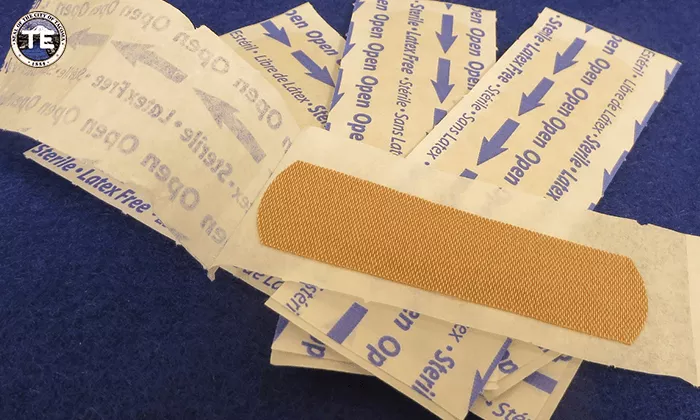Recent studies have highlighted a concerning presence of per- and polyfluoroalkyl substances (PFAS), also known as “forever chemicals,” in many commercially available bandages. This revelation points to potential health risks for consumers and significant environmental concerns.

Discovery of PFAS in Bandages
Investigations conducted by Environmental Health News (EHN), Mamavation, and various independent researchers have found that approximately 65% of bandages tested contain PFAS. These substances are prevalent in both the adhesive flaps and the absorbent pads that come into direct contact with wounds.
Brands implicated in these findings include major names like Band-Aid, CVS, and Walmart among others. PFAS are used for their moisture resistance and adhesive properties, but their inclusion in everyday health care products like bandages is highly questionable due to their toxic nature.
Health Risks Associated with PFAS
PFAS chemicals are linked to several adverse health effects, including cancer, liver damage, thyroid disease, and developmental issues. The nature of bandages means these chemicals can potentially enter the bloodstream through open wounds, presenting a direct route for contamination. The Environmental Protection Agency (EPA) and other health bodies have flagged PFAS for their persistence in the environment and the human body, making them a long-term concern for public health.
Industry Response and Regulatory Challenges
The findings have spurred calls for bandage manufacturers to eliminate PFAS from their products. Despite these concerns, there is a lack of stringent regulatory measures to control the use of PFAS in personal care products, leading to significant gaps in consumer safety. Some brands tested did not show detectable levels of PFAS, demonstrating that it is feasible to manufacture effective bandages without these harmful chemicals.
Environmental and Policy Implications
The widespread use and persistence of PFAS raise broader environmental issues, as these chemicals do not degrade naturally and accumulate in the environment and living organisms. The recent studies advocate for more robust regulations and transparency in the use of PFAS in consumer products to mitigate environmental damage and potential health risks.
The presence of PFAS in such a common and essential product as bandages is a wake-up call for both consumers and manufacturers. It underscores the urgent need for stricter regulations and proactive measures by companies to eliminate these hazardous chemicals from their products, ensuring safer options for wound care and environmental protection.
Consumer Awareness and Advocacy
The revelation about PFAS in bandages has sparked a significant response from consumer advocacy groups and environmental watchdogs who are pushing for greater transparency and reform in product labeling and safety standards. Consumers are encouraged to be vigilant and seek out PFAS-free products, supported by organizations that offer lists and guides for safer alternatives.
This proactive approach by consumers can drive demand for safer products, compelling manufacturers to reconsider the use of PFAS and prioritize health and safety over cost-saving measures. Increased awareness and consumer advocacy play crucial roles in catalyzing change within industries reluctant to modify their practices without external pressure.
The Role of Research and Development in Phasing Out PFAS
To address the PFAS problem comprehensively, there is a critical need for innovation and research in the development of alternative materials that do not compromise product quality or safety. Research institutions and developmental labs play pivotal roles in discovering viable substitutes for PFAS that can be used in medical products and other consumer goods.
Funding and support for such research are essential to enable a shift towards sustainable and non-toxic materials, helping to phase out the use of forever chemicals in everyday products while ensuring the health of the population and the integrity of the environment are not compromised.

Carl Riedel is an experienced writer and Open Source Intelligence (OSINT) specialist, known for insightful articles that illuminate underreported issues. Passionate about free speech, he expertly transforms public data into compelling narratives, influencing public discourse.













